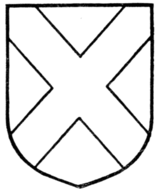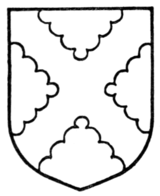constant occurrence. From early illustrations there is now no doubt that this was the original form, or one of the earliest forms, of the cross crosslet. It is foolish to ignore these varieties, reducing all crosses to a few original forms, for they are now mostly stereotyped and accepted; but at the same time it is useless to attempt to learn them, for in a lifetime they will mostly be met with but once each or thereabouts. A field semé of cross crosslets (Fig. 183) is termed crusilly.
THE SALTIRE
The saltire or saltier (Fig. 184) is more frequently to be met with in Scottish than in English heraldry. This is not surprising, inasmuch as the saltire is known as the Cross of St. Andrew, the Patron Saint of Scotland. Its form is too well known to need description. It is of course subject to the usual partition lines (Figs. 185-192).
When a saltire is charged the charges are usually placed conformably therewith.
The field of a coat of arms is often per saltire.
When one saltire couped is the principal charge it will usually be






